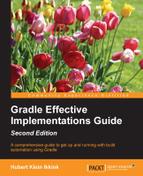In this chapter, we discussed how to run JUnit or TestNG tests from a Gradle build. We also saw how to get the test results and reports that are generated by executing the tests.
With the application plugin, we discussed how to create a distributable ZIP file with all the code and scripts necessary to run the Java application that we have built.
We have also discussed how to upload our project artifacts to a repository so that other projects can use our code. We have seen that we can use Gradle to create an artifact that is ready to be uploaded to a Maven repository.
To digitally sign our artifacts, we saw how to use the signing plugin together with locally-installed PGP tools.
Also, we saw how we can use the war and ear plugins to create web and enterprise applications with Gradle. We can use tasks, methods, and configuration properties to configure the packaging output.
In the next chapter, we will look at how to run and create a multi-module project with Gradle. We will also discuss how to create dependencies between projects and apply a common configuration to multiple projects at once.
